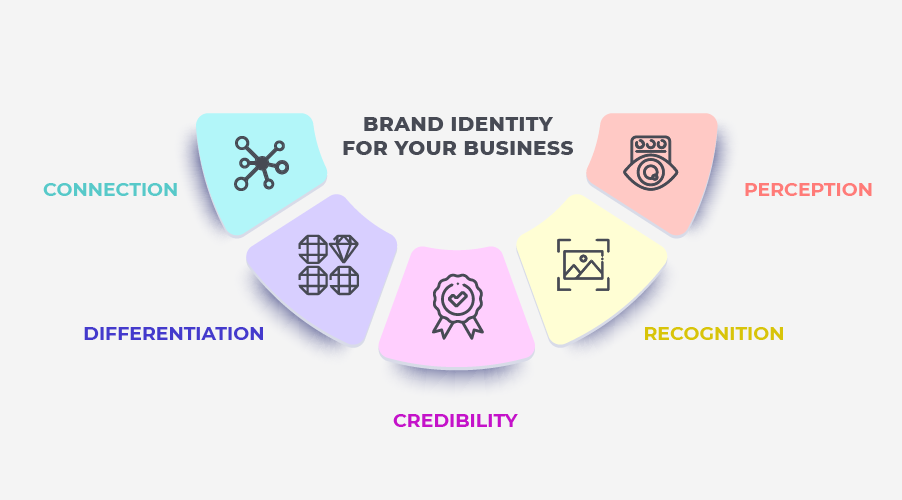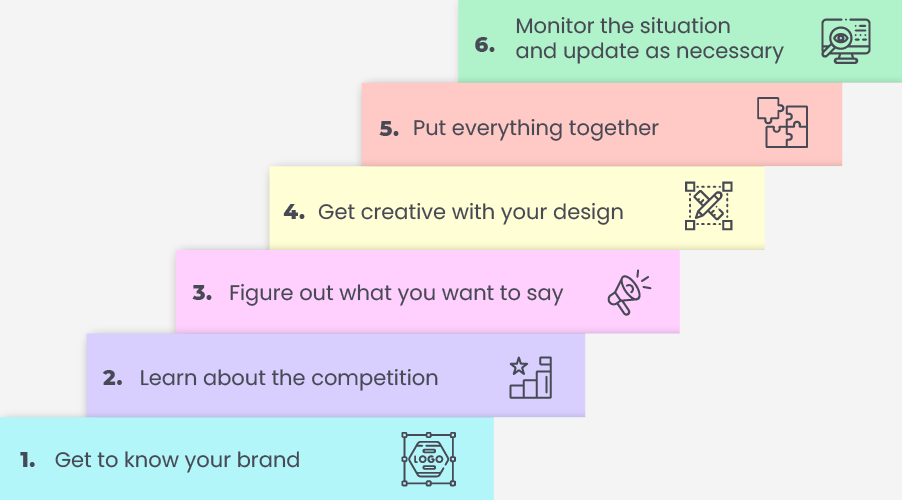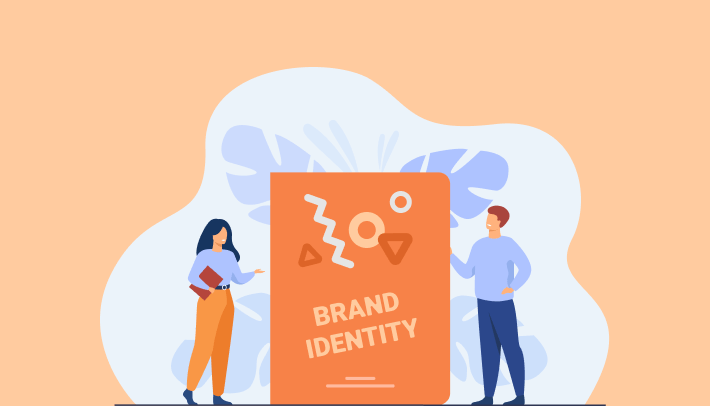Brand identity. It’s one of the buzzwords that all the cool business people throw around — but what exactly does it mean?
Contrary to a popular belief, branding is not:
- Just your logo and trademark
- Marketing or advertising
- A trendy business fad that you can ignore
- Just a tool for big companies
Okay, we know that’s not really a helpful definition of brand identity — but that’s coming soon, we promise. 😉
The point is that a lot of businesses share these common misconceptions about branding, and they couldn’t be more wrong.
Want to stand out from the competition, make positive connections with your audience, and showcase your company? Brand identity is the way to do it.
If you’ve ever questioned the term brand identity or if you’re looking for ways to strengthen yours, this post is for you. We’re going to dive into what brand identity is, why it’s so important, and how to create a brand identity that shines. 💎
What Is Brand Identity?
Imagine the iconic McDonald’s catchy tagline, Nintendo’s multicolored logo, UPS’s brown and gold color scheme. That’s all brand identity. Your company identity is one of the most powerful branding and marketing tools your business will ever have.
But what exactly is it? Here’s one brand identity definition to ponder:
Brand identity is all the visible aspects (i.e., color, design, logo, etc.) that help consumers distinguish and identify your brand.
While brand identity plays a role in brand image, it also is so much more. It uses colors, shapes, and other visual elements for advertisements, promotions, packaging, etc.
Here are a few other ways we can describe brand identity:
- It’s the unique visual elements and style of your brand.
- It’s how the world sees your company (i.e., brand image).
- It’s what makes you stand out from the competition and instantly recognizable to customers.
- It’s the outward expression of your values, mission, goals, and personality.
A solid brand identity design communicates who you are without the need for long pages of written content. 🤓 It’s what gives you leverage in the visual space.
Brand identity design is important — but that doesn’t mean it’s easy.
Get the pro-grade help you need with designers from Epiic.
Every successful business needs a brand identity — let’s look at a detailed “why” below. 🧐
Why Does Your Business Need a Brand Identity?

With the brand identity definition out of the way, our next step is understanding what makes identity so important. Here are five of the main benefits of cultivating a strong brand identity.
Connection
Your brand identity ties together every aspect of your business, from your website to product packaging. The result? A professional, consistent look for your company. Your brand identity can also give current and potential customers something personal to connect with.
Differentiation
There are millions (if not more) of companies to compete with. Your brand identity can help you stand out so that customers are more likely to notice and remember you.
Credibility
Consumers are more likely to buy from brands they know and trust. 💡 Developing — and maintaining! — a professional identity gives you credibility in the marketplace. A consistent presence and recognizable brand can quickly make you appear as an authority in your industry.
Recognition
Like relationships or personal grooming habits, taking the time to cultivate your brand identity is only going to help you in the long run. Your brand identity can make you recognizable and memorable, making it easier to promote your business.
Perception
If you want the public to see you in a certain way, brand identity matters. Your visual elements (logo, color palette, typography, visuals, etc.) may be subtle, but they still speak for you. Your identity design is one of the tools that allow you to influence the way consumers think about your brand.
How to Create a Brand Identity in 6 Easy(ish) Steps

Unfortunately for all of us slackers out there, the perfect brand design doesn’t emerge fully formed and ready for use when a business is born.
These six steps may look easy on the outside, but don’t be deceived! 😉
Get to know your brand
It’s hard to build an identity if your brand is a stranger; take some time to get to know your business before doing anything else. Here are a few things you should know about your brand:
- Your brand personality, voice, and style
- Your / brand’s overall goals
- Your core principles, mission, and values
- What makes your brand unique
Pro TIP! It may help to perform a SWOT (Strengths, Weaknesses, Opportunities, and Threats) analysis as well.
Learn about the competition (so you can beat them)
Market research may be a four-letter word to some 😁, but it’s nonetheless a vital part of developing your brand identity.
One of the main benefits of a brand identity is that it can help differentiate you from the competition. That means it’s important to know what everyone else in your industry is doing so that you can do it differently or better.
Now is also a good time to learn more about your target audience. What do they want? Where do they go to get what they want? What do they like / dislike about your competitors?
Figure out what you want to say
What do you want your brand identity to say about your business?
Now’s the time to sit down and figure out how you want the world to see you.
❗ Consider this:
- What emotions you want your brand to evoke;
- What key traits you want consumers to associate with your brand;
- What you want your customer to value most about your brand;
Once you know this, you can create a consistent and effective brand message that all your visual elements will work towards.
And remember! Your message should be consistent, relevant, and truthful to be effective.
Get creative with your design
Start with the building blocks of brand identity: color, font, and visuals.
And – make sure that you don’t choose design elements based purely on personal taste. 😉
Building a successful brand identity is a lot of work.
Luckily, our Epiic designers are always here to lend a hand.
Put everything together
Nailing the three creative design elements will allow you to build additional brand identity tools such as a website, logo, and more.
Whether you’re designing an email template, in-house newsletter, or branding a company van 🚐💨, aim for a look that’s consistent across the board.
Monitor the situation and update as necessary
It would be nice if the brand identity process was a one-and-done sort of thing. However, that’s not the case.
It’s important to document your brand identity during the development process and monitor it after all is said and done. Remember that your business and target audience are going to grow and change over time — be flexible with your identity.
Design — The Building Blocks of Your Brand Identity

Brand identity is all about visuality, which means that it’s important to consider your design with care.
Below you’ll find some of the main facets of brand identity design and what you should pay attention to for each one.
Developing your design
Before you can build your brand identity, there are a few important elements you need to focus on. Take care when developing your brand design. These elements may seem based on taste, but what you choose at this stage can affect your company throughout its life. Nail the three building blocks below and you’ll be able to develop more physical elements of brand identity with ease.
1. Color palette
Color is one of the most impactful and emotionally appealing design building blocks you’re going to work with. Choosing the right colors can help differentiate your brand and appeal to consumers. The wrong colors can be ineffective or downright obnoxious.
When choosing a color palette, we recommend picking a variety of colors for maximum flexibility and effect. A few main colors and several secondary colors will allow designers to create unique and compelling designs. Too many colors and you risk the palette becoming overwhelming and ineffective.
Your color palette will be used for everything from business cards to your logo and website. If you have a physical location, it will likely be incorporated there as well. As such, it’s important not to choose color palettes based on personal taste, preference, or what is popular with your competitors.
Remember, this is your chance to stand out from the crowd and make an impact. Instead, base your selection on your brand’s personality, values, and mission.
2. Typography
Commonly known as font or type, your typography style is what your written content looks like. Unlike color, typography isn’t very noticeable to the average consumer unless you get it very, very wrong.
The main typography types that you can work with:
- Serif — Scholarly and classical fonts (think Times New Roman)
- Sans serif — Fonts that lack “feet,” making them more streamlined and modern
- Script — Handwriting fonts that mimic cursive and look elegant and luxurious
- Display — Bold, eye-catching fonts that have a unique element such as shadowing or outlining
To determine your typography style, it helps to know what kind of brand personality you’re working with. Are you strong and masculine? Delicate? No-nonsense? Sophisticated and aloof?..
Understanding your brand personality can help you choose the right typography.
3. Iconography & visuals
Your visuals (images, sketches, iconography, etc.) can either make a statement or cause confusion and chaos. It’s important to choose visuals wisely! Here are some tips to keep in mind:
- Find images that don’t mimic the competition’s choices. If you must use stock photos, stick with unique ones.
- Iconography can be impactful. Remember that round shapes, sharp shapes, and straight lines all have a different visual weight.
- Different images have different styles — make sure that the ones you choose are relevant and appropriate.
Designing your identity
Once you’ve picked out the right building blocks, you can begin…well, building! The following elements are the tangible fruits of your design efforts. As you design your brand identity, you may find that some of them are more important than others. For example, your online website design business may require an amazing website but not need much in the way of product packaging.
Here are a few examples of some of the most important elements that can help augment your brand image.
1. Logo
Few brand identity elements are as important to your success as a logo. Even if you’re the most innovative, state-of-the-art, amazing brand in the world (and we don’t doubt that you are 😉), a lackluster logo is going to drag you down.
Your logo is one of the most visible and instantly recognizable things about your company. And because it’s going to appear on everything from your website to your product packaging, it needs to be a statement piece. A great logo is unique, memorable, relevant, instantly recognizable, and helps bring your brand to life.
Be sure that your logo uses all your building blocks (color, typography, and iconography) effectively to make a positive impact.
2. Company website
A good website is worth its weight in gold these days (or at least worth your computer’s weight in gold). Your site is one of the most widely accessible visual elements of your brand. It doesn’t matter if you’re selling website design, cybersecurity, personalized candles, or the latest clothes. A good chunk of potential customers will inevitably visit your site before committing to your brand. As such, your website should simply ooze brand identity.
3. Emails
Email can be a great way to connect with your audience and customers, but only if people read what you send. A great email design can help set you apart from the rest of the inbox. 💪
Of course, there are hundreds of different reasons you might send out an email, so it’s important to create an email design that furthers your goals. An introduction email will look entirely different from a monthly newsletter. Also important is to stick to a template that fits your brand identity. This will help ensure all your emails are instantly recognizable.
4. Business cards
Nothing says “traditional professional” like a good, old-fashioned business card. Of course, nothing says “unsure business venture” like a poorly designed card. Yes, business cards can be a great way to network and market your brand, but only if they’re not saying the wrong thing.
A simple card that reflects your brand identity via logo, color palette, and typography looks classy and makes a stellar statement.
5. Brand style guide
Don’t you hate it when you spend years developing the perfect brand identity, but the new design team has its own ideas? Don’t worry, this happens all the time. To brands without guidelines anyway.
Avoid the headache of clashing designs by developing a brand style guide. This manual should discuss every element of your design, from logo to color palette to everything in between. Be sure to include examples, details, visuals, and any other relevant information. This will allow future designers to replicate your brand style and personality on their creative terms.
Remember, a successful identity relies on consistency over time. That being said, it should still maintain some flexibility.
We all wish we could have the pro look without the pro price tag.
Well, sometimes wishes come true. 😉
Identify Yourself — Stand Out from the Crowd with a Great Brand Image
Brand identity isn’t just for big business — every company can benefit from it! Remember that your brand needs to appeal to a highly visual audience. What better way to do so than by really focusing on the visual elements of your brand design?
Your brand image depends on nailing a great brand identity design and sticking to it. It’s got to be accurate, memorable, relatable, and aesthetic. In short, it’s got to be some of the best work you’ve ever created.
It doesn’t matter if you’re starting from scratch or revamping your current look. When you give your brand identity a little time and attention, you’re sure to see huge payoffs in the future.
What brands can you pick out of a crowd? What brands do you consistently use just because you like them? What brands make you feel happy? Some of the great brand identity examples that come to our minds are:
- Apple’s iconic logo
- The classic Coca-Cola color scheme
- The world-famous Nike swoosh
In a nutshell, the six steps to developing a brand identity are:
- Research your brand to discover who you are.
- Research your customers and competition.
- Determine the message you want to communicate.
- Decide on your creative design elements.
- Build your brand identity.
- Keep an eye on things and change as needed.
There are many parts involved in brand identity. Some of the most important include:
- Logos and wordmarks
- Typography
- Images and image style
- Iconography
- Color palette
- Tagline
These factors influence brand identity elements such as websites, emails, business cards, and more.
Feb 10, 2022




Andy Zenkevich
Andy is a seasoned CEO with years of hands-on experience in SEO, link building, content marketing and website development. His deep understanding of the digital landscape and passion for content marketing make him a trusted voice in the industry.